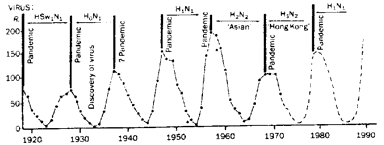 |
Science Frontiers ONLINE No. 68: Mar-Apr 1990 |
|
|
Periodical Invasions Of Aliens
Forget those contemporary tales of UFO landings and human contacts with their alien navigators. Aliens have been land-ing here and mixing with the human populace for centuries. In fact, their traffic peaks about every 11 years, just when the solar cycle reaches its maximum. By now, you've probably guessed that F. Hoyle and N.C. Wickramasinghe are again talking about flu pandemics and sunspots. You must admit, however, that their correlation is becoming more and more convincing.
 Yearly means of daily sunspot numbers correlated with dates of flu pandemics |
Key to the Hoyle-Wickramasinghe argument is their contention that simple life forms (viruses, bacteria, etc.) not only exist in outer space but likely evolved there. If so, how do they ride in to afflict us on the peaks of the solar cycle? Here's how, in their words:
"In conclusion, we note that electrical fields associated with intense solar winds can rapidly drive charged particles of the size of viruses down through the exposed upper atmosphere into the shelter of the lower atmosphere, the charging of such particles being due to the photoelectric effect. This could define one possible causal link between influenza pandemics and solar activity."
(Hoyle, F., and Wickramasinghe, N. C.; "Sunspots and Influenza," Nature, 343: 304, 1990.)
Reference. Periodic epidemics are cataloged in BHH3 in: Biological Anomalies: Humans II. To order, visit: here.